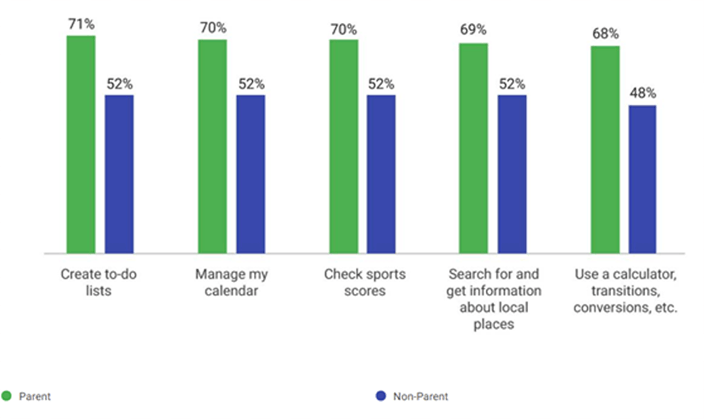Women hold up half the sky, they also make the majority of purchasing decisions. In the US
- 93% of food purchases are made by women
- 92% of holiday planning is done by women
- 85% of household expenditure is the responsibility of women
- 50% of products typically marketed to men are bought by women
Source: Social Media Today
It does make you wonder what men are doing with their time.
If you add parenthood and family responsibility into the mix it becomes obvious why marketers get excited about “marketing to mums” and the spending power that they wield. That excitement however, needs to be tempered by the understanding that this is a vast and diverse group. Approaching it as a homogenous group and then passively sitting back and waiting for marketers’ pearls of wisdom will lead to accusations of paternalism and worse.
SEO and the Mum, Mom and Mammy audience
As mentioned this is a diverse group. In the States mothers are “moms”, “mums” in the UK and any number of variations throughout the rest of the English-speaking world. And while, for example, in the USA 85% of births are to women under 35, 66% of mums are aged 35 plus. Additionally, to make the mix even more varied 1 in every five US “Moms” is also a millennial; according to Social Media Today. Phew… complex and diverse.
So when it comes to optimising sites designed to be found by the “mom” audience its worth thinking in great depth about the customer.
We do know that mums, or moms, are most likely to be online with their mobile or cell phones. Women aged between 25-54 who have children spend 54% of their online time on their phones compared to 48% of those without. We’re willing to hazard a guess that women with children online, on their phones are probably well practiced at using it with one hand while multi-tasking with the other.

The modern mother is also using voice search coupled with the use of smart speakers (Source: eMarketer). While according to Google parents are around 20% more likely to use smart speakers for a whole range of tasks. This feels like the natural progression from searching one handed on a mobile to searching using voice, why tap out searches on a small screen when you can speak them? So ideally your website needs to have lots of content which reflects those spoken questions.
PPC, Remarketing and the Mum Audience

Reminding potential customers about the products they left in their checkout baskets or even just viewed before moving on is, when used with precision, undeniably effective. A leisure retailer gets 11x return on ad spend from carefully targeted paid search and remarketing ads.
Care and subtlety, however, should be the watch words when using these powerful tools. You need a well thought out strategy based on a clear understanding of the audience.
When Mumsnet surveyed its community, it found that almost half (46%) agreed that “personalisation is the future”, so it makes sense that advertisers do the same and 49% agreed that “I’d rather see ads that fit my age/personal situation/ online behaviour than random ads”.
However, when asked “What do you think about ads from one website you’ve viewed popping up on a completely different site?” 32% said “I hate it” but interestingly 26% said “It depends what the ad is for”. Saying “sometimes it’s fine, though sometimes it’s really intrusive”. The survey went on to ask about what products were and were not appropriate for remarketing. Amongst respondents’ concerns were the possibility of ads being seen by either their children or partners.
Amongst the products respondents didn’t want to see in remarketing ads were:
-
- Lingerie 81%
- Daily underwear 76%
- Presents for other people 65%
- Medical products 79%
- Sex/adult products (toys etc) 92%
The last two are covered by Google’s policies. But there is a real need to conduct remarketing strategically and with care. It’s definitely worth considering if you wouldn’t be better off harvesting demand with eCommerce SEO, ensuring that customers find you when they are searching for the products or services that you sell.
Social Advertising to Parents
Research by Social Media Today has shown that mothers reach out to their peer group for support, advice and recommendations by using social media. In the US, 88% of mothers use social media and of those 59% access social networks multiple times a day, 66% turning to social media for parenting advice.
That’s a lot of people online and engaging with each other using these platforms, talking and sharing information. As a company its really important that you are seen to engage with these communities and have strategies in place to deal with any negative comments and criticisms. Whilst Paid Social Advertising can grab attention, cut through the noise and drive sales, undirected and unplanned targeting aimed at mothers could miss the point and potentially backfire.
To serve relevant ads marketers should consider starting with audiences made up of their customers and their friends, likely to be in similar life situations and expanding the campaign incrementally to encompass similar audiences.
To help make sure that marketers serve relevant ads, it may be worth targeting audiences that you know have demographics that are relevant to your products or services, people that are in similar life situations for example. Once the results from that start coming in you can then slowly expand the campaign to take in wider ranging audiences.
The best results are then achieved by expanding the campaign to take in other groups with different interests. The mantra here being to test test test. One tool for this, recently introduced by Facebook is life event notifications, this helps accurately target people based on, demographics, location, interests and behaviours. Information is key and as we know the “mum” market is diverse and complex. One size does not fit all.
Mum may not be the word

It’s vital that marketers understand the complexity and diversity of marketing to the mum audience. The research warns against crude stereotyping. Marketing Week’s 2014 article The Five Myths of Marketing to Mums still contains some killer advice for anyone tempted to ignore the subtleties of marketing to this audience. It also includes the pertinent stat taken from research by Saatchi & Saatchi, that only 23 per cent of UK mothers are happy with anyone other than their families calling them ‘mum’. So tread carefully.
And a final thought, according to the ONS in the UK getting on for three quarters of women with dependent children are part of the workforce, the US figures are very similar. Look around, you may spot one or two to ask.
To keep up-to-date with more eCommerce marketing trends and statistics, subscribe to our ThoughtShift Guest List, or request a request a free digital marketing analysis.






